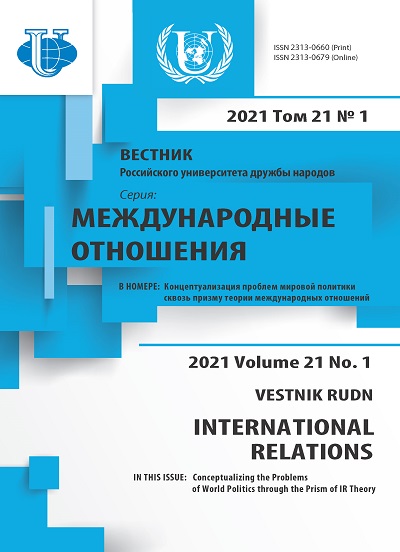Mutual Perception in Contemporary Relations between Russia and Iran: Image of Russia and Iran in History School Textbooks of the Two Countries
- Authors: Zotova J.A.1
-
Affiliations:
- Islamic Azad University
- Issue: Vol 21, No 1 (2021): Conceptualizing the Problems of World Politics through the Prism of IR Theory
- Pages: 157-170
- Section: BILATERIAL RELATIONS
- URL: https://journals.rudn.ru/international-relations/article/view/25964
- DOI: https://doi.org/10.22363/2313-0660-2021-21-1-157-170
Cite item
Full Text
Abstract
Russia and Iran have maintained continuous diplomatic relations since 1592. During the post-Soviet period, relations between the Russian Federation and the Islamic Republic of Iran have strengthened significantly. The leaderships of both countries seek to turn their relations into a strategic partnership. However, the main obstacle to achieving this goal is the negative perception of the other by the peoples of both countries. The purpose of this study is to understand how modern Russians and Iranians see each other and the relations between their governments. This article examines data from sociological surveys, opinions of Russian and Iranian experts, and analyzes the images of Iran and Russia presented in school-level history textbooks of the two countries. We note negative stereotypes and a distrust of Russia among modern Iranians. Russia receives far more attention in Iranian history textbooks than Iran in Russian ones. For Iranians, the image of Russia as a neighbor is more important than the image of Russia as a great world power. However, the image of Russia in general is negative; Russia is seen as a country to be feared. The negative image of Russia among Iranians is formed through selective and often erroneous interpretation, rather than historical facts. Although opinion polls in contemporary Russia divulge a generally positive image of Iran, the country is not seen as important to respondents - it remains distant, exotic, and incomprehensible. Modern Russians have very faint ideas about their Southern neighbor, Iran. Persia and Iran receive so little attention in Russian school textbooks that it is difficult to talk about the image of this country as positive or negative.
About the authors
Julia Aleksandrovna Zotova
Islamic Azad University
Author for correspondence.
Email: juliazotova@yahoo.fr
PhD in Slavic studies (Sorbonne University), Associate Professor
Tehran, Islamic Republic of IranReferences
- Digard, J.P., Hourcade, B., & Richard, Y. (2007). L’Iran au XXème siècle: Entre nationalisme, islam et mondialisation. Paris: Fayard. (In French).
- Flichy, Th., Holtzinger, J.-M., Paris, J., & de Premonville, A.L. (2013). Chine, Iran, Russie: un nouvel empire mongol? Limoges: Lavauzelle. (In French).
- Floor, W. (2004). Tea Consumption and Import in Qajar Iran. Studia Iranica, 33(1), 47—111. doi: 10.2143/SI.33.1.563194
- Karami, Dj. (2017). Marhele-e djadid az mosharekat-e rahbordi iran va russie. Hamkariha-e iran va rusie: abad va cheshm andaz [A New Phase in the Strategic Relations between Iran and Russia. In I. Ivanov & M. Shoori (Eds.), Russia-Iran Partnership: Current State and Prospects]. Tehran: IRAS (pp. 29—39). (In Persian).
- Katz, M.N. (2012). Russia and Iran. Middle East Policy, 19(3), 54—64. doi: 10.1111/j.1475-4967.2012.00547.x
- Kozhanov, N.A., & Bogacheva, A.S. (2020). The Islamic Republic of Iran in Search of its Foreign Policy Identity: Revolutionary Innovation or Continuity? MGIMO Review of International Relations, 13(2), 141—162. (In Russian). doi: 10.24833/2071-8160-2020-2-71-141-162
- Larionova, A.Yu. (2012). Formation of the Image of Persia and Persians in Russia and USSR in 1880—1971 [thesis]. Moscow: RUDN University. (In Russian).
- Laruelle, M. (2009). Le berceau aryen: mythologie et idéologie au service de la colonisation du Turkestan. Revue Cahiers d’Asie centrale, 17/18, 107—131. (In French).
- Mamedova, N.M. (2010). Mutual Interests of Russia and Iran: Historical Evolution and the Current Stage. In V.Y. Belokrenitsky, I.V. Zaytcev & N.U. Ulchenko (Eds.), Russia and the Islamic World: Historical Retrospective and Contemporary Trends. Moscow: IV RAN publ. (pp. 29—38). (In Russian).
- Parker, J.W. (2009). Persian Dreams: Moscow and Tehran since the Fall of the Shah. Dulles, Virginia: Potomac Books Inc.
- Polishchuk, A.I., Soboleva, A.S., & Karimi Riabi, E.E. (2018). Development of Russian-Iranian Cultural Relations at the Beginning of the 21st Century. Vestnik RUDN. International Relations, 18(2), 368—386. (In Russian). doi: 10.22363/2313-0660-2018-18-2-368-386
- Richard, Y. (2009). L’Iran: de 1800 à nos jours. Paris: Éditions Flammarion. (In French).
- Sanaie, M. (2008). Barresi ravabet-e iran va rusie [Evolution of Relations between Russia and Iran]. Mahname IRAS, (21), 6—8. (In Persian).
- Sazhin, V.I., & Karami, J. (2017). Strategic Partnership between Russia and Iran in a New Phase: What Can We Offer Each Other? In I.S. Ivanov (Eds.), The Partnership between Russia and Iran: The Current State and Prospects for Development. Moscow: RSMD publ. (pp. 11—33). (In Russian).
- Shlapentokh, D. (2012). Russian Elite Image of Iran: From the Late Soviet Era to the Present. Carlisle, PA: Strategic Studies Institute.
- Shnirelman, V.A. (2011). Arkaim: Archaeology, Esoteric Tourism and National Idea. Forum for Anthropology and Culture, (14), 133—167. (In Russian).
- Shnirelman, V.A. (2015). Aryan Myth in the Modern World. Moscow: Novoe literaturnoe obozrenie publ. (In Russian).
- Troudi, M.F. (2009). Les relations irano-russes: vers une alliance contre l’influence américaine. Approche historique. Géostratégique, (24), 157—177. (In French).
- Yurtaev, V.I. (2009). The Failed Orange Revolution. Politicheskij klass, (8), 54—75. (In Russian).
- Yurtaev, V.I. (2015). Russia and Iran: The Problem of Strategic Partnership. In E.V. Dunayeva & V.I. Sazhin (Eds.), Russia — Iran Relations. Problems and Prospects. Moscow: IV RAN publ. (pp. 36—50). (In Russian).











